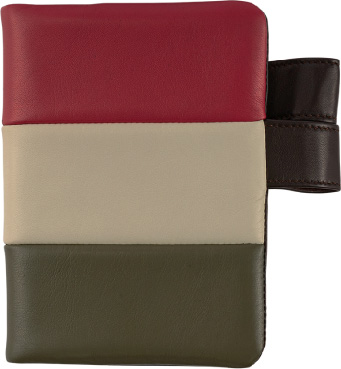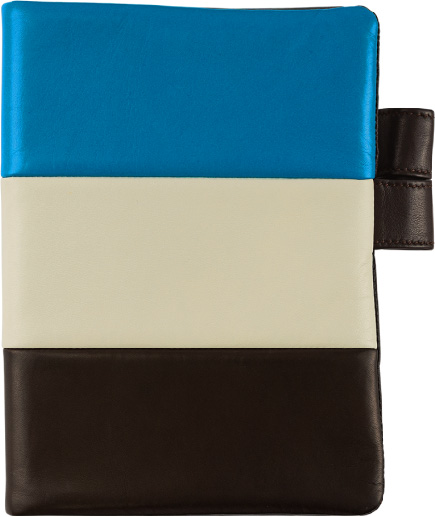A Gift from Ethiopia
This year’s andu amet techo cover uses Ethiopian sheepskin that’s amazingly soft to the touch. We talked to andu amet representative and designer Hiroko Samejima about the secret to this special leather and her thoughts about craftsmanship.
> About Hiroko Samejima

- “Bloom”
A6 size cover

- “Nile Breeze”
A5 size cover
− Part 2 of 2 −
Individually hand-made in an Ethiopian workshop
- So you founded the company andu amet, which includes a shop in Tokyo that sell bags and other goods as well as a workshop in Ethiopia. How many people work in the workshop?
- Samejima
- There are 14 people on staff. There are experts, and then assistants working under the experts to support them while also learning the trade.
- So it’s like a mentor and apprentice relationship.
- Samejima
- Right. And the main process involves each expert taking full responsibility and creating a product from start to finish, rather than following an assembly-line approach.
- Wow! So everyone knows how to do the entire manufacturing process.

- Samejima
- Yeah. We want to foster a sense of love and responsibility in people toward the work that they do.
- It’s really satisfying to get a product that’s been created like that.
- Samejima
- If you’re using machines or assembly-line processes to create cakes, and your job is to put strawberries on top, you’re not going to feel much affection for the cake when you see the finished product. That’s going to pale in comparison with the quality you get when a patisserie creates a wedding cake, personally picking out the ingredients and deciding on the decorations. If I got to choose, I’d rather make something the way the patisserie does.
- Yeah.
- Samejima
- The way I see it, there are two kinds of quality products out there. One is a product that is made with high specifications: high quality materials, design, and technique. The other is a product that was crafted with so much love you can just feel it. But it doesn’t matter how advanced the design or technique that produces your product is—if that’s all it has, it’s going to feel differently from a product whose beauty comes from being made with love and having a backstory. What we’re aiming for is products that have both kinds of quality.
- Looking at pictures of your workshop, everyone seemed to be having a great time. It looked very tightly knit. And it made me happy to be able to see the faces of the people making the products.

- Samejima
- The way I see it, there are two kinds of quality products out there. One is a product that is made with high specifications: high quality materials, design, and technique. The other is a product that was crafted with so much love you can just feel it. But it doesn’t matter how advanced the design or technique that produces your product is—if that’s all it has, it’s going to feel differently from a product whose beauty comes from being made with love and having a backstory. What we’re aiming for is products that have both kinds of quality.
- Looking at pictures of your workshop, everyone seemed to be having a great time. It looked very tightly knit. And it made me happy to be able to see the faces of the people making the products.
- Samejima
- Thank you. The way we see it, a product is not completed once it leaves the hands of the creator; it’s made into something wonderful when it’s loved by the person who uses it and takes care of it.
- So it’s not complete until it’s used. That’s the same as the Hobonichi Techo.
- Samejima
- Oh, you’re right! So in order for these products to be loved, the person making it must love it as well. And that’s why we have a single person create each product from start to finish.

The flowers and winds of Ethiopia
- The two designs for this year’s covers are Bloom for the A6 and Nile Breeze for the A5. What’s the story behind these designs?
- Samejima
- Bloom is modeled after spring in Ethiopia. There are two main seasons in Ethiopia: the dry season and the rainy season. Beyond that there’s just a brief, light rainy season in the middle. It’s really interesting — during the Ethiopian rainy season you’ll see crazy storms that last all day, but in the dry season, there won’t be a drop of rain for months at a time.
- So it’s raining constantly or not at all.
- Samejima
- The ground gets so dry that cracks form along the ground. But once spring comes, and it begins to rain, the land turns green and blooms with flowers. So flowers in Africa have this image of spreading and blooming across the earth.
- Wow, I’d love to see that someday.
- Samejima
- The Nile Breeze design is modeled after the refreshing, gentle breeze that blows along the Nile River. The Nile River has a strong association with Egypt, but one of the starting points of the river is actually in Ethiopia. Water that originates in Ethiopia and flows toward Egypt makes up this great, majestic river that gives life to the land of Africa.

- It’s also striking how cushioned these designs are.
- Samejima
- We’ve got a series of bags at andu amet that we call the HUG Collection. We took those designs and turned them into techo covers. And in order for users to fully enjoy the soft feel of the leather, we insert a spongy material underneath the leather to give it some plump.
- This seriously feels really nice to the touch.
- Samejima
- When I first set out to make bags through andu amet, I wanted them to be more than just a tool for carrying things around. I wanted them to serve as a symbol of love, and to have a presence as you carry them around every day. The people who carried them would be able to enjoy Ethiopian sheepskin with all five senses, and fully enjoy its comfort by hugging it in their arms. I wanted to replicate that same experience with the Hobonichi Techo covers, so that’s how I came up with this design. While the leather is delicate, I’d love for users to experience the full appeal of leather.
- Yes, we hope Hobonichi Techo users will hug their Bloom and Nile Breeze covers and experience the softness for themselves. Thank you!

Photography: andu amet (Ethiopia), Hiroyuki Oe (techo covers)< Part 1 / BACK